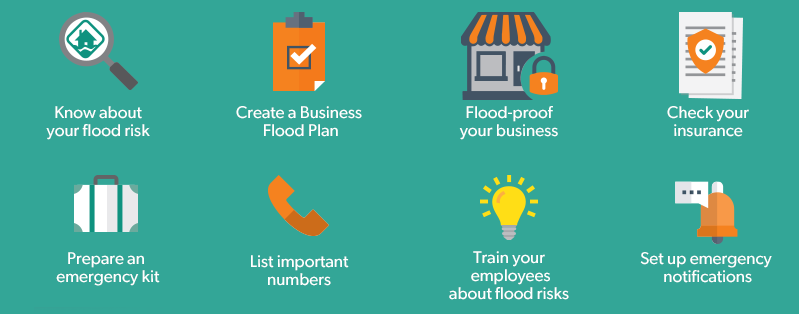How will floods and storms affect your business?
Your home can be affected by flooding,but so can your business. Think of how much you could lose in stock, equipment and fittings due to a flood, along with profits for the days or even weeks it can take to clean up after a flood or storm event.
Planning and preparing for emergencies at work includes making an emergency plan; using your local flood guide; learning about sandbagging; knowing who is in charge at your workplace; preparing your employees with emergency training sessions, and knowing what steps to take when emergencies happen.
So:

How will floods affect your business?
If your business is close to a river, creek, major storm drain or in a low-lying area, then you may be at risk.
Life
-
Most flood deaths occur when people enter floodwater. Floods can be life-threatening to you, your employees and your customers.
Property
-
Floods cause hundreds of thousands of dollars’ worth of damage to business stock, plant, equipment, furniture and fittings every year.
-
Damage can be caused by water inundation; debris; humidity; contamination; mold and power disruption.
-
Insurance policies that cover your business for flood damage may be difficult to obtain and can be expensive.
Profits
-
Your business may have to close for an extended period of time. It usually takes a week or more to clean up after a flood, adding to your costs and stress.
-
It can take several weeks or months for your business to return to normal. Your customers may take their business elsewhere.
Develop an emergency plan for your business
Developing a Business Flood Plan:
Take steps to prepare yourself and your business for a flood by creating a Business Flood Plan using the template below. Early preparation will help lower the risk of flooding to your business.
-
Comply with Occupational Health and Safety (OH&S) regulations.
-
Reduce damage to stock, plant, equipment and fittings.
-
Reduce the amount of time that you can’t trade.
-
Ensure customers will return when trading commences.
-
Minimise the loss of profits.
-
Protect employment.
-
Protect your business reputation and image.
What to think about when developing your Business Flood Plan:
Identify what the main impacts are on your business and prioritise them:
-
People’s health and safety are compromised.
-
Property is damaged or destroyed.
-
Profits are lost or service provision stopped.
-
Paperwork and records are ruined.
-
Other potential impacts.
Manage your plan:
-
Train all your employees to have knowledge and understanding of the actions and requirements.
-
Ensure the details of the plan are up to date.
-
Review your plan periodically, significantly after a flood event.
Sandbagging:
Sandbagging is a great way to help protect your business:
-
Find out where you can purchase them from your local supplier
-
Watch our sandbagging video to ensure you know how to use them, fill them, lay them and safely dispose of them if they have been contaminated by floodwater.
-
Download our sandbagging flyer and include it with your Business Flood Plan.
Understand how emergency warnings affect your business
Not only do you need to understand how you'll handle an emergency at home, but you also need to consider your workplace, either as an employee or an employer.
Take the time as a business owner to understand the warnings information available on the VICSES website.
Stay informed by ensuring you are notified of any flood events in your area by:
-
Downloading the VicEmergency app.
-
View key information about understanding warnings on the VicEmergency website.
-
Following VicEmergency on social media - Follow VicEmergency on Facebook and Twitter for real-time warning notifications.
-
Knowing the frequency of your local emergency broadcaster
-
Read about Flood Warning Services on the Bureau of Meteorology website.
Does your business operate outdoors?
Restaurants and cafes with outdoor area are often affected during storms. Loose items such as outdoor furniture, umbrellas and movable barriers that are commonplace with outdoor dining venues can quickly become dangerous in the event of thunderstorms or strong winds.
How can outdoor dining venues be better prepared?
-
When designing your outdoor layout, consider your location and what risks to consider that may arise from a strong or severe weather event.
-
Ensure that outdoor items such as tables, chairs, umbrellas and mobile barriers are tied down or safely secured.
-
Regularly clean gutters, downpipes and drains to ensure they are not blocked.
-
Make a plan that can be acted upon quickly to demobilise area if severe weather forecast.
-
Stay informed with the latest weather information and warnings and know what the warnings mean (e.g. severe weather warnings are issued by the Bureau of Meteorology for sustained winds of gale force (63 km/h) or more, wind gusts of 90 km/h or more, or very heavy rain that may lead to flash flooding).
-
Monitor severe weather warnings and forecasts via the Bureau of Meteorology website or app, and warnings via the VicEmergency website or app.
Do you manage a caravan or holiday park?
Business case study: The Mill, Castlemaine
Castlemaine business The Mill shares the importance of being prepared and having a Business Flood Plan, and how to be self-sufficient in the event of a flood to reduce the necessity to fully rely on emergency service assistance.
Do you manage a caravan or holiday park?
The Victoria State Emergency Service wants to assist caravan and holiday parks with planning and preparing for an emergency.






